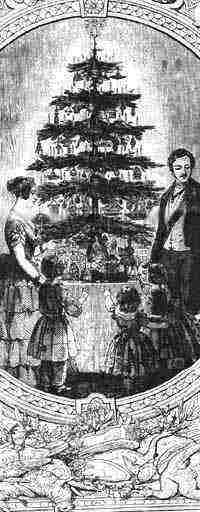The Pre-Christian History of Christmas

The celebrations in December did not start with Christmas. They existed for thousands of years before Jesus was born. They are the beginnings of our traditions.
History reveals that, under various names, the Christmas holiday has been celebrated for thousands of years. It was an ancient pagan celebration throughout Europe long before it was adopted by the early Christian church.
This celebration was usually centered around the winter solstice. On the shortest day of the year, ceremonies were performed to insure that the days began to lengthen again. The early church knew, as most people know who are trying to change the behaviors of other people, that if it wanted the pagans to celebrate the birthday of Jesus, it would be easier to alter what was being celebrated than to try to obliterate the celebrations altogether and start over again.
His birth date was settled on a few hundred years after Jesus was said to have died, so nobody really knows for sure what happened when. If the Bible is to be believed, shepherds were out with their sheep at night(Luke 2:8), and that normally only happens when lambing begins, which is a springtime event.
At any rate, the mid-winter celebration was practiced as a purely pagan event for thousands of years. In the northern lands, It meant that the cold could be survived, and throughout ancient Europe, it meant that spring would come again, animals would be born and the land would yield crops to eat.
Feasting, hanging evergreen boughs and other greenery that survived at that time of year and having candles and bonfires for light were included in most pagan celebrations. In Scandinavia, the Yule log was burned during Yuletide, which was the first day the sun rose again after several days of darkness in the far north. It was said to represent the victory of the rising sun over the dark, and to keep bad spirits away.
Decorating a tree began when people tied apples to the branches of trees as a reminder that the warm, fruitful days would come again. Over time, evergreens and other trees were decorated in different ways in different places. Martin Luther was said to have decorated the first Christmas tree in Germany.
The current Christmas tree custom known in Europe and America was started when an illustration was published of Prince Albert and Queen Victoria gathered around a decorated tree with their children. The tree had been decorated in Germany, and the custom had been brought to England earlier by German kings, but they weren't popular. So that custom didn't take until the population imitated Queen Victoria and her family. At that time, it was decorated with candles which were lighted on Christmas Eve.
Holly is still used for decoration at Christmas as it has been used for thousands of years and by many ancient cultures. In pre-Christian times, holly was considered protection and good luck for males. It's name is not a derivative of "holy" as is often thought, but comes from very old Indo-European word roots that refer to its prickly nature. It was the sacred plant of Saturn, and was used for decoration by the ancient Romans during the mid-winter celebration of Saturnalia, which lasted for days and could become very bawdy and wild. Holly's counterpart for women in ancient times was ivy. The carol "The Holly and the Ivy" refers to this combination. That carol shows the adaptation of holly and ivy from pagan to Christian beliefs.
The original mistletoe revered by the ancients, especially the Celts, Greeks, and Germans was the oak mistletoe. In America and Europe today, another more common variety of mistletoe is used for decoration at Christmas. Ancient oak mistletoe was thought to have mystical properties, to bring fertility and life, to land on an oak tree via lightening, etc. It was cut by the Druids only at summer and winter solstice. During Saturnalia, Roman couples kissed under the mistletoe to bring fertility. It was also placed above doors in ancient times as protection against evil.
Giving gifts and hanging stockings by the chimney also have long histories. Gifts were given by different cultures around the winter solstice, and they were also given by Romans to celebrate a festival around our January 1st. They decorated their homes with greenery, and gave each other sprigs of greenery and honey and cakes. Then the Romans celebrated for days, much as they did during Saturnalia. Needless to say, with two major celebrations in a few weeks, nothing much was done in the Roman Empire during late December and early January. This custom was carried with the Romans as they expanded their empire.
In the Germanic countries, the Norse god, Odin, was thought to be leading a hunting party through the sky, and riding his great horse. The children would leave their boots by the chimney, filled with straw and other food for the horse, and a grateful Odin would then put candy or gifts in the boots. Later, gift giving was associated with St. Nicholas, who was known for his charitable giving, and later became Santa Claus.
So if you celebrate Christmas as a religious holiday or a pagan holiday - or if you prefer instead to celebrate winter solstice - you are following traditions practiced by many generations. Presently, Christmas has been smothered in advertisements and sales, but, as it always has, it is still changing. Some groups of people are deliberately taking it back to the simpler celebration of gathering together and celebrating that it once was.










